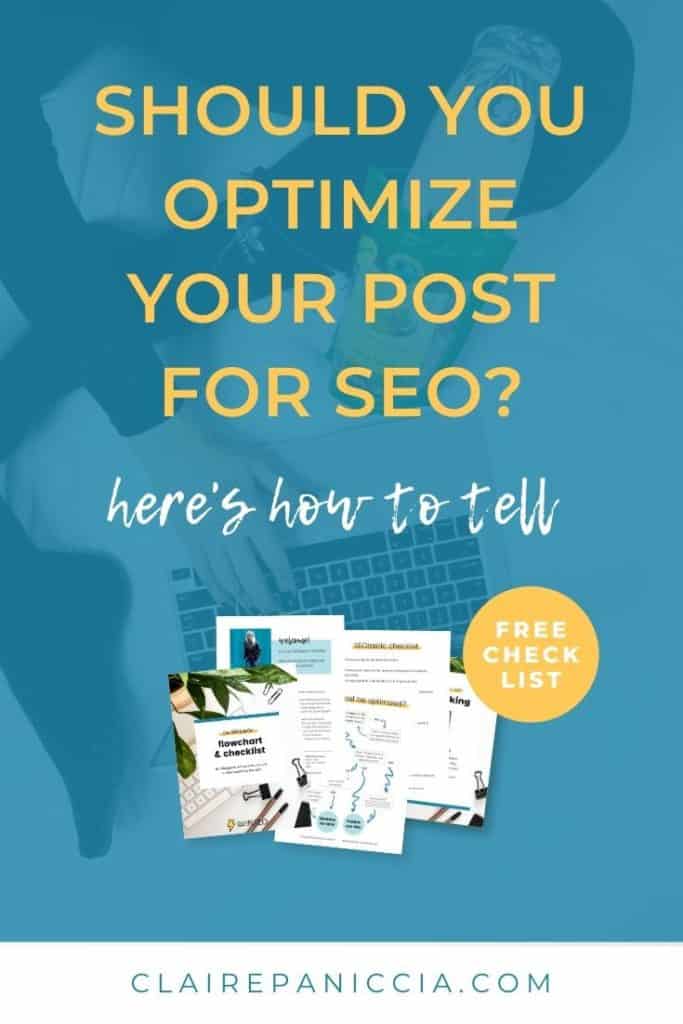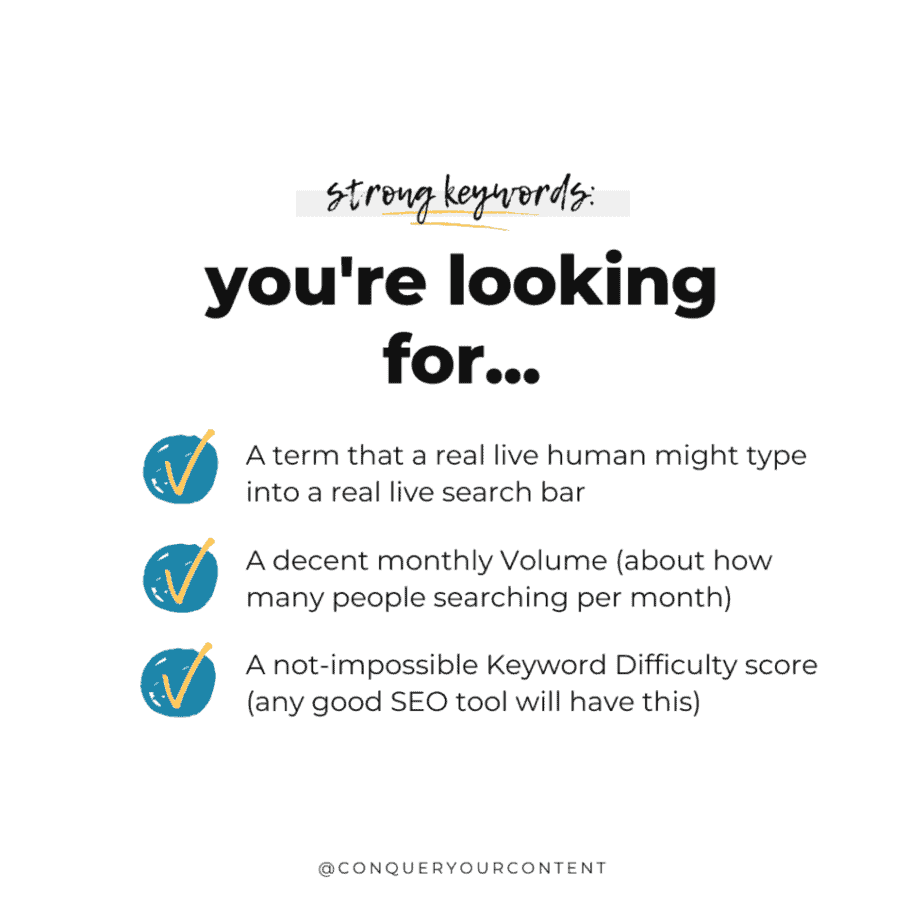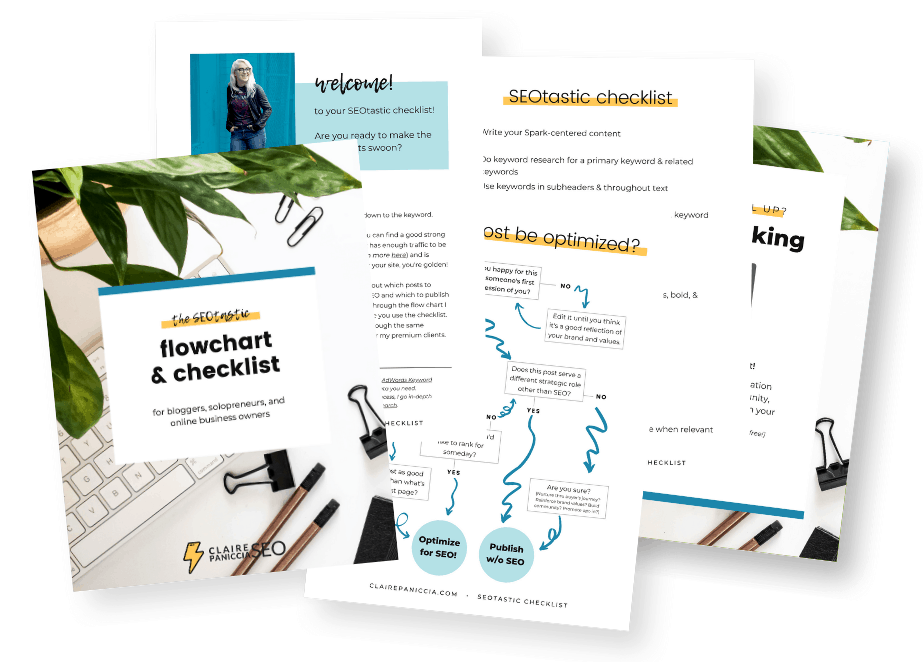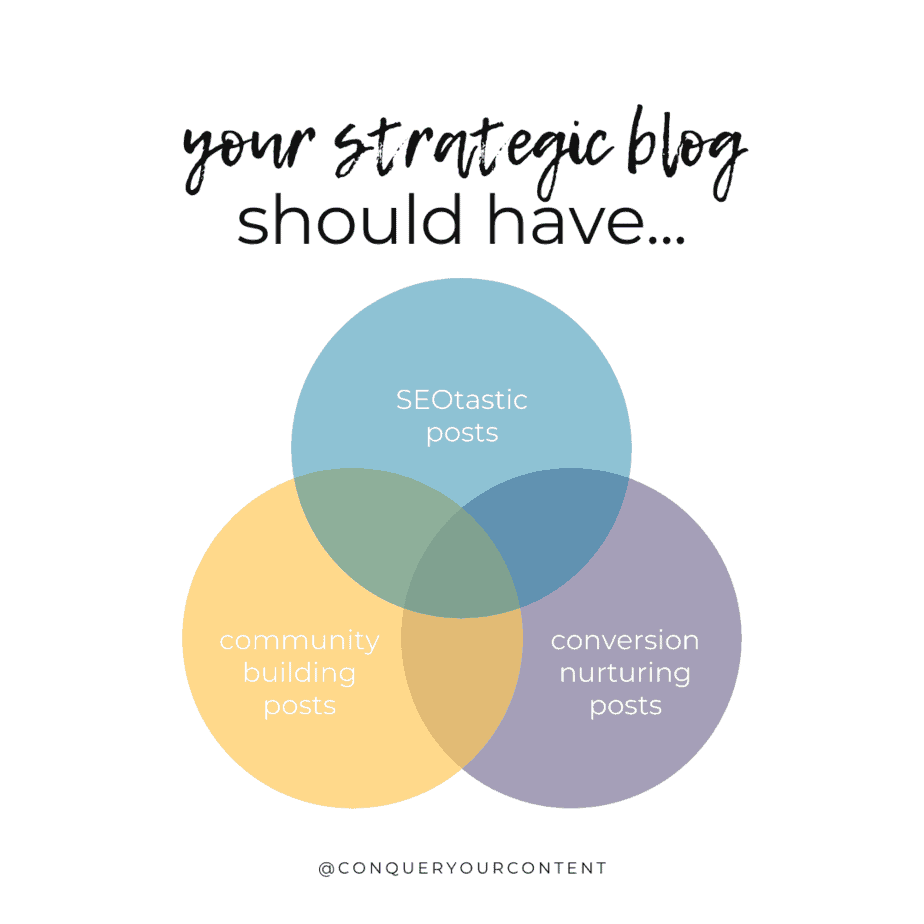
There’s a big misconception that you have to optimize every single post for SEO before you hit publish.
This myth is perpetuated by a lot of SEO checklists out there, as well as the general confusion around SEO and how the heck it works/what the heck it is/how the heck to do it.
I doubt any other SEO would tell you this, but here’s the truth:
Not all your content has to be SEOtastic.
Here’s my process to figure out which posts to optimize for SEO, and which to publish without it.
Your content can serve different strategic purposes
You see, your blog is going to have all kinds of content that will all serve different purposes in your content marketing ecosystem.
SEO is only one of those purposes.
Some of your blog posts will be nurturing readers towards a conversion, like downloading your free opt-in, purchasing a product, or becoming a client.
Other content will be all about reinforcing your brand values and building community (I’m all about those spicy rants).
And some content will be SEOtastic.
This is why I always tell people to write the content you want to write first.
Write from a place of Spark, and add in the Strategy after. Or as I like to say on Instagram, #sparkfirst
To complicate things even more, some blog posts can serve more than one purpose,
For example you might write a post meant to reinforce brand values, but it also happens to be SEOtastic. To which I say: awesome!
That also means that some of your posts won’t be SEOtastic at all, which means any time you spend optimizing it for SEO is wasted time. To which I say: booooo!
The best way to avoid this is to spend a few minutes checking to see if the post has SEO potential before you even think about optimizing it.
Here’s how to check if your post has SEO potential
[mailerlite_form form_id=13]
Is it ready to be someone's first impression of you?
After you’ve written your #sparkfirst blog content, you’ll want to first make sure that it’s something you’d be happy to be someone’s first impression of your brand.
This includes the obvious, like typos, formatting, on-brand tone.
You also want to make sure it’s a good reflection of your values (gender-inclusive? Non-appropriative language?)
Then I really want you to check for this: if someone had no idea who you were, and they landed on this blog post, would they understand what was going on?
Introductions are notorious here.
A lot of times, we want to talk to our audience like our close friends. And that’s absolutely a great thing to do to help foster know-like-trust with our voice, especially as a personal brand.
But we also have to keep in mind that even our closest followers might not have read everything we’ve ever published.
So if your blog post is building on concepts you’ve outlined in past content, or if you’re telling a story about that launch you did last month, you can’t write your post assuming they read that content already or saw that launch.
And if someone’s never heard of you before and knows nothing about your brand or business? Talking as if they do can make them feel out-of-the-loop, like that acquaintance standing there awkwardly while everyone else is making inside jokes.
No one wants to feel like that, and on the internet when there are a literal gazillion other places they could hang out instead, they’ll hit that back button faster than your goldfish forgets its name.
Is there a strong keyword?
The next step is the one that is the literal most important step any time you ever even begin to think about SEO for your blog content.
You’ve got to make sure it’s worth the effort and time to optimize.
And you do that by making sure there’s a decent keyword to target.
Now, I’ve written about keyword research before, so I won’t rehash it all here for you.
| (Related posts: What is keyword research? and Stop choosing keywords the wrong way!) |
But in general, here’s what you’re looking for:
- A term that a real live human might type into a real live search bar if they were looking for the info in your blog post
- A decent monthly Volume (this means approximately how many people search the keyword per month)
- A not-impossible Keyword Difficulty score (any SEO tool worth its salt will give you some kind of score system to indicate how hard they think the keyword will be to rank for)

What a “good” Volume or a “good” Keyword Difficulty score is will vary by industry, so I can’t give you a range to aim for. But I will venture that for Volume, don’t target anything too far below 100. At that point you’re scrounging for pennies in the couch cushions.
At this stage, you’re not doing full on keyword research yet, so don’t stress about finding the exactly perfect target keyword for your post. You’re just looking to see if there seems to be a few options for potential target keywords.
Like if you needed new towels and you’re checking to see if the stores in your area even carry towels before you drive there. (don’t know why that metaphor popped into my head, but we’re gonna go with it)
Are some of those keywords achievable for your site?
If you’ve established that there seems to be some search traffic for keywords that make sense for your post, the next step is to check the search engine results page (SERP) for the keywords you’re looking at to determine if any of them are achievable for your site.
To continue the towel metaphor, after you find a couple of stores that carry towels, you check to make sure they’ve got towels in your price range.
This is the step where the quick keyword check might start blending into full-blown keyword research (eg. you’re online checking to make sure the store has towels in your price range, but in your head you’re secretly also picking out a few favorites).
This is important for small businesses and solopreneur sites because for most of us, our sites don’t have the clout that Wikipedia, Forbes, REI, or Social Media Examiner have (yet 😏 ). Those sites can grab pretty much any keyword they want. (there’s a lot to explore in this dynamic, but that’s for another time)
For us, we’re going to be a bit more selective in order to make sure our time and effort are only put towards keywords that are more likely to pay off.
Side note: If you can’t find a keyword that’s achievable for your site right now, were any of them keywords that you’d like to rank for someday? If yes, I say call it an aspirational keyword and optimize away!
Overtime, your site might be able to jump in the ring for the first page someday!
Is your post as good as or better than the results on the first page?
As a last step before you optimize your blog post, make sure it’s up to snuff for the first page of Google for whatever keyword(s) you’ve chosen to target.
If there were a handful of sites on the first or second page that were comparable to yours (i.e. not wikipedia), check out their content.
WARNING!: This is not the time to start playing the comparison-game or getting overwhelmed or feeling hard-done-by! Wikipedia, and anyone else you’re comparing yourself to, started exactly where you started! Your content and site are amazing and valuable and worthy! Put that comparisonitis away, focus on your Spark and everything that sets you apart, and get back to work!
What you’re looking for here are signals or clues of what the Googlebots have determined are what people are looking for here.
Do the posts tend to have a lot of images? Are there a lot of list posts? Do a lot of them seem to mention a certain subtopic?
Make sure your post meets and exceeds the Googlebots’ expectations for this keyword, and make any tweaks, additions, or changes needed (without going against your brand, values, or message. Always always always prioritize those over any algorithm expectations, every single time).
If you answered No to any of these, does it have a different strategic purpose?
Like I said at the beginning of this post, not all your content has to be SEOtastic.
If you answered No to all of the above, this post probably serves a different strategic purpose.
Get clear on its strategic role, and make sure you’ve set it up to serve that purpose well!
If you answered yes to all of these, your post has SEO potential!
Optimize your post for SEO and make it SEOtastic!
Download my free SEOtastic Flowchart & Checklist. You’ll get a one-page flowchart to walk you through this whole process visually, and a quick-reference SEO checklist so you don’t forget any piece of the puzzle when you’re making your content SEOtastic.
Free SEOtastic Flowchart & Checklist


